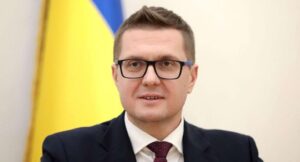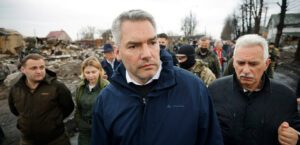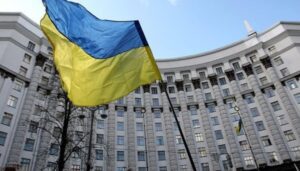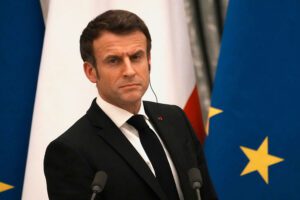
Head of the Security Service of Ukraine Ivan Bakanov said that the operation to detain People’s Deputy of Ukraine, former co-chairman of the Opposition Platform for Life party Viktor Medvedchuk was carried out on behalf of President of Ukraine Volodymyr Zelensky, according to the telegram channel of the special services on Tuesday evening.
“I thank all the SBU employees, in particular, the investigators and counterintelligence officers of the Ukrainian special services, who, following the instructions of the President of Ukraine Volodymyr Zelensky, proved their professionalism and carried out this lightning-fast and dangerous multi-level special operation to detain MP Medvedchuk for the time being. Not a single traitor will escape punishment and will answer according to the law of Ukraine, to the fullest extent, for all the crimes that his personal actions led to, including,” Bakanov said.
The SBU message is illustrated with a photograph of Medvedchuk in camouflage uniform and handcuffed. It also contains text that reads: “You can be a pro-Russian politician and work for an aggressor state for years. You can be a fugitive lately. You can even wear a Ukrainian military uniform to disguise. But will it help you get away from punishment? “Handcuffs are waiting for you. And traitors to Ukraine like you! Pro-Russian traitors and agents of the Russian special services, remember – your crimes have no statute of limitations. And shelter, wherever we find you!”
Earlier, on Tuesday evening, a photograph of Medvedchuk in military uniform and handcuffs appeared on the Telegram channel of Ukrainian President Volodymyr Zelensky. It was accompanied by the text “A special operation was carried out thanks to the SBU. Well done! Details later.”

Austrian Chancellor Karl Nehammer informed Ukrainian President Volodymyr Zelensky about the results of negotiations with Russian President Vladimir Putin, ORF reports citing the Austrian Federal Chancellery.
According to the channel, Nehammer told Zelensky that the meeting was not a “friendly visit.”

The Cabinet of Ministers has established that combatants and civilians affected by Russian military aggression will be able to receive rehabilitation means, regardless of the establishment of disability
“The government has adopted a decision developed by the Ministry of Social Policy that systematically simplifies the receipt of auxiliary means of rehabilitation for people affected by the war of Russia against Ukraine, both military personnel of the Armed Forces of Ukraine and other military formations, and volunteers of territorial defense, and civilians,” the press release says. -services of the Ministry of Social Policy.
It is noted that the government’s decision: expands the list of persons who are provided with assistive means of rehabilitation, in particular, persons who were injured, contused, mutilated or ill during service, labor and other activities aimed at protecting the country during Russia’s military aggression against Ukraine, and as a result of living in areas of hostilities or in areas subject to bombing, airstrikes and other military attacks.
The decision also provides an opportunity for combatants and victims of Russian military aggression to receive auxiliary rehabilitation means, regardless of the establishment of disability, at the conclusion of military medical commissions or medical advisory commissions of healthcare institutions.
In addition, the solution provides for persons with disabilities who were in the area of hostilities and require rehabilitation funds, but have lost the documents necessary to obtain them, the opportunity to obtain them without the appropriate documents.
“Territorial offices of the Social Protection Fund for Persons with Disabilities will check the data on a person with a disability in the Centralized Data Bank on Disability Issues, and in the absence of information in the data bank, they will facilitate the receipt of the necessary documents at the place of residence or stay,” the message says.
Among other things, the Cabinet of Ministers: granted the right to early replacement of rehabilitation means to people who lived in the areas of hostilities during the military aggression of Russia, at their request on the basis of a certificate of registration of an internally displaced person; simplified the submission and consideration of documents for prosthetics and orthotics with products of increased functionality, manufactured using the latest technologies and technologies that are not available in Ukraine, or special products for sports for military personnel, volunteers of the territorial defense forces and other persons involved in the provision. defense of Ukraine; expanded the list of enterprises where people can order the necessary rehabilitation products, taking into account their needs and medical indications; granted combatants the right to receive financial assistance for the purchase of liners made of silicone or gel composition for the stumps of the upper and lower extremities in case of prosthetics and orthotics with products of increased functionality.

The Ministry of Energy intends to create two industry-specific cyber centers in the electric power and oil and gas sectors on the basis of previously created cyber centers at NPC Ukrenergo and NJSC Naftogaz, Farid Safarov, Deputy Minister of Energy for Digital Development, Digital Transformation and Digitalization, said.
“The Ministry of Energy sent a draft order to the Cabinet of Ministers on the definition of two industry centers. In it, the two cyber centers created on the basis of Naftogaz and Ukrenergo were referred to as industry cyber centers. It is assumed that Ukrenergo will be responsible for the energy sector, for the oil and gas industries – Naftogaz, – Safarov said at an online briefing “Cyber threats in war: cyber attacks on Ukrainian regional energy companies” on Tuesday.
According to him, such proposals were developed as part of an agreement with the National Security and Defense Council and the Security Service of Ukraine, as well as interaction with the government’s CERT-UA computer incident response team.
The Deputy Minister explained that industry cyber centers will be built on the principle of a pyramid.
“At the first level, the enterprises themselves must carry out organizational and technical actions in order to prevent possible damage, above them there is the level of monitoring of industry centers based on Ukrenergo and Naftogaz, which, in turn, are already interacting directly with key cybersecurity stakeholders,” – Safarov explained the mechanism.
In his opinion, the creation of such industry centers will significantly enhance the cyber defense of energy facilities, which are the most vulnerable group of critical infrastructure.
“In order to simplify the work of colleagues from CERT-UA, to coordinate and make their intervention more effective precisely at critical moments, we are building this architecture,” the Deputy Minister noted.
As reported, since the beginning of the war, the number of cyber attacks on energy infrastructure facilities has almost doubled – over 200,000 cyber attacks were committed in 47 days of the war, while 900,000 of them were recorded in the entire 2021.

French President Emmanuel Macron said that at this stage he does not plan to visit Kyiv, as he does not believe that such a visit will bring concrete results.
“I think that in my case a trip to Kyiv would make sense only if it can bring real benefits to Ukrainians,” he explained his position to French journalists.
According to Macron, he is not going to visit the Ukrainian capital for the time being, because he does not want to “follow fashion’s lead.”
At the same time, the French president assured that he welcomes the recent visits to Kyiv by other European leaders, as “this shows European solidarity.”